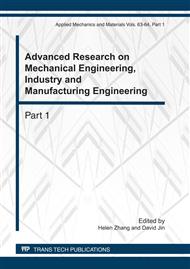p.318
p.322
p.327
p.333
p.337
p.341
p.345
p.350
p.355
Development of Stretchable Conductors by Depositing Gold Trace on Pre-Stretched Silicon Thin Film
Abstract:
Stretchable conductors have more applications than traditional non-stretchable ones. Some of the examples can be the conductors in a bendable laptop or a bendable cell phone. This paper will focus on the manufacture of a stretchable conductor for the development of a pressure sensor system for the measurement of the body contact force of a tubular device with its environment, such as colonoscope. The conductor in this application will need to stretch up to 50% without the decrease of conductivity. The stretchable conductor is made by depositing a conductive material with good elasticity, such as gold trace, to a pre-stretched substrate, such a silicon rubber thin film. An Electron Beam Evaporator machine is used to make the deposition. Experimental results show that the conductivity of the conductor will keep unchanged even the stretch is up to 100%.
Info:
Periodical:
Pages:
337-340
Citation:
Online since:
June 2011
Authors:
Keywords:
Price:
Сopyright:
© 2011 Trans Tech Publications Ltd. All Rights Reserved
Share:
Citation:


